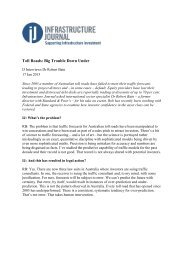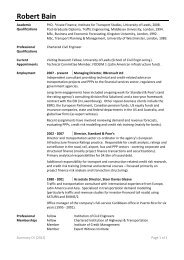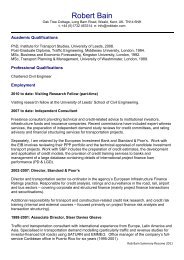Disincentivising overbidding for toll road concessions
Disincentivising overbidding for toll road concessions
Disincentivising overbidding for toll road concessions
- No tags were found...
Create successful ePaper yourself
Turn your PDF publications into a flip-book with our unique Google optimized e-Paper software.
DISINCENTIVISING OVERBIDDING FOR TOLL ROAD CONCESSIONS<br />
A later paper by Flyvbjerg, Holm and Buhl (2005) looked at demand- or benefit-side bias, in terms of how projects<br />
per<strong>for</strong>m in comparison to <strong>for</strong>ecasts. Studying a sample of 210 projects across 14 countries, with a combined value<br />
of US$59 billion, the authors found that, while nine out of ten rail passenger <strong>for</strong>ecasts exceeded outturn traffic (with<br />
an average overestimate of 105.6%), overestimation was not as acute a problem in <strong>road</strong> traffic <strong>for</strong>ecasts; in fact, <strong>road</strong><br />
traffic <strong>for</strong>ecasts (<strong>for</strong> <strong>toll</strong>-free <strong>road</strong>s) were underestimated on average.<br />
There is no significant difference between the frequency of inflated versus deflated <strong>for</strong>ecasts <strong>for</strong> <strong>road</strong> vehicle<br />
traffic...21.3% of projects have inaccuracies below –20%, whereas 28.4% of projects have inaccuracies above<br />
+20%. Road traffic <strong>for</strong>ecasts were underestimated by an average of 8.7%. 10<br />
However, the authors found that the difference between actual and <strong>for</strong>ecast traffic was greater than ±20% <strong>for</strong> half of<br />
all <strong>road</strong> projects. Moreover, 13% of <strong>road</strong> projects had <strong>for</strong>ecast inaccuracies larger than ±60%, suggesting a large risk<br />
of error.<br />
Turning to <strong>toll</strong> <strong>road</strong>s, Bain (2009) used a dataset of over 100 <strong>road</strong>, bridge and tunnel case studies compiled by<br />
Standard & Poor’s. 11 The Standard & Poor’s programme analysed the ratios of actual traffic numbers to those<br />
<strong>for</strong>ecast. Ratios smaller than 1.0 suggest an overestimation in the <strong>for</strong>ecast numbers. Bain found that the observed<br />
ratios ranged between 0.14 and 1.51 (i.e., from actual traffic being only 14% of the <strong>for</strong>ecast to actual traffic exceeding<br />
the <strong>for</strong>ecast by 51%), with a mean of 0.77.<br />
These results are indicative of a large range of error and, since the mean is less than 1.0, a systematic tendency to<br />
overestimate traffic <strong>for</strong>ecasts, with actual traffic volumes 23% below the <strong>for</strong>ecast levels, on average. In other words,<br />
the average <strong>for</strong>ecast overestimated the level of traffic by approximately 25%. Bain argued that similar results were<br />
found in a 1997 J.P. Morgan study of 14 US <strong>toll</strong> <strong>road</strong>s, as shown in Table 2.1. 12<br />
Table 2.1 Errors in <strong>toll</strong> <strong>road</strong> traffic <strong>for</strong>ecasts<br />
J.P. Morgan study<br />
Bain study<br />
Sample size 14 104<br />
Location USA International<br />
Forecasting per<strong>for</strong>mance (ratio of actual/predicted traffic)<br />
Minimum 0.18 0.14<br />
Average 0.58 0.77<br />
Maximum 1.17 1.51<br />
Source: Bain (2009), op. cit., p. 473.<br />
Photograph courtesy of Road and Maritime Services, NSW.<br />
10 Flyvbjerg et al. (2005), op. cit., p. 133.<br />
11 Bain, R. (2009), op. cit.<br />
12 J.P. Morgan (1997), ‘Examining Toll Road Feasibility Studies’, Municipal Finance Journal, 18:1, Spring.<br />
12






